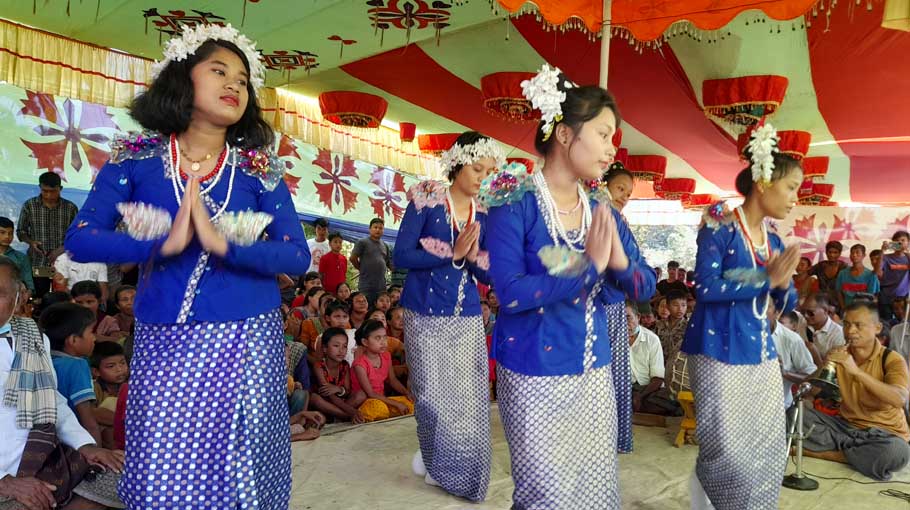Ethnic community members welcome new Jhum crops

Jhum farmers spend a lot of time in paddy cutting, threshing, drying of paddy and making rice from the paddy. When the harvest of long 6-7 months of hardships is at home, the farmers do not celebrate the festival alone, they organises a joyous festival along with their neighbors and relatives.
This has been the long standing tradition of the hill people of Chattogram Hill Tracts for hundreds of years. However, this festival is a timeless tradition not only in the hilly areas but also in the plains of the country. This festival started in Bandarban on Tuesday.
People of Marma community call this festival of eating new rice (Koksai Cha: -poye:); Chakma people say (Nuyo Bhat Hana); Tripura community say (Maikta Chamo Pan Da); Chak community say (Angna in Book); Khumi community say (Changtha Cha Pai); Khiyang community say (Loo Bu Ta: Poi :); Bom community say (Thlai Thar) and the Mro community members call this (Ningsar Hum). In Bengali this festival is called Nabanna Utsav.
Read More: Off-beat crops can change hill economy
At the beginning of the day’s programme, Mangnuching Marma, the director of Bandarban Khudra Nri-Gosthi Sangskritik Institute (KNGSI), spoke about their activities. He said that KNGSI is providing all necessary assistance for the preservation of the endangered heritage and culture of the hill tribes. The Nobanno Utsav organized by Bandarban Minority Cultural Institute on the occasion of Marma Community's Nobanno Festival called Koksaicha: Poye O and Loksanskritik Utsav 2021 was held at Ubanu Marma’s jhum field on Tuesday. The Nobanno festival was presided over by Si Aung Khumi, a member of the Bandarban Hill District Council. AKM Jahangir, Chairman, Bandarban Sadar Upazila Parishad was present as the Chief Guest, Raju Mong Marma, Vice Chairman, Bandarban Sadar Upazila, Mong Nu Ching Marma, Director, Minority Ethnic Cultural Institute, Bandarban, Assistant Director Jing Alhab, Leela Mro Locals including Marma President Bangladesh Awami League, Bandarban Sadar Upazila, Thoai Hla Pru Headman (Mouza Pradhan) and Karbari (Village Pradhan) of different neighborhoods.
The chief guest said that 40 years ago the hill people used to respect the traditional tradition. If you see a cross mark on a stick in the place of a hill then you will understand that someone has fixed a place for Jhum and no hill occupies that place anymore. But lately that traditional respect is being lost which is sad. The culture, history and traditional heritage of all ethnic groups must be protected.
Jum farmer Uba Mong Marma describes from start to finish what it takes to cultivate Jhum, what machinery is needed and what seeds are needed. Si Aung Khumi said that 30-35 varieties of companion crops are available in Jhum. He also said that they have to protect their history, culture and heritage.
Cakes of different names of Marma community - Pakei Muh, Hnain Baik Muh, Kong Nyang Bong, Gung Muh, (Oil Fried) The guests are entertained by making different cakes. A variety of fruits and vegetables produced by Zum are on display, along with Zum cultivation equipment, seeds and materials.
At the end of the program, a pleasant folk dance cultural program of Marma community was performed by the cultural workers of different neighborhoods.




